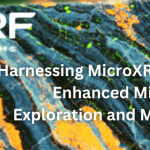

A Study by IXRF Systems
The journey to understanding human growth and development traverses unexpected but fascinating scientific routes. The study of human baby teeth and bones, far from being purely dental or orthopedic research, offers a unique lens into a child’s overall health. A particularly innovative analytical approach for understanding growth and development involves high-spatial-resolution microXRF. This powerful tool provides an in-depth analysis of the elemental composition of teeth and bone down to 5μm pixel diameter. This blog post by IXRF Systems delves into the application of microXRF in studying biomineralisation in teeth.
MicroXRF
MicroXRF (Micro X-ray Fluorescence) spectroscopy is an advanced analytical technique used for non-destructive elemental analysis with high spatial resolution. While it shares the same foundational principles as XRF, microXRF allows researchers to scrutinise materials at microscopic levels. By directing an ultrafine X-ray beam – as small as 5µm – onto the sample, the technique excites atoms, and as these atoms revert to their ground state, they emit X-rays at wavelengths that are distinctly unique to each element. This feature allows users to identify and quantify the elements. MicroXRF can detect, quantify and map the spatial distribution of elements in solid, tissue, liquid, and powdered samples with minimal preparation.
MicroXRF for Studying Biomineralisation in Teeth and Bones
MicroXRF allows for the non-destructive examination of the elemental composition and distribution in teeth and bones. As children grow, trace elements from their environment and diet are integrated into their teeth and bone structures. Just like tree rings, teeth provide a chronological record of exposure to these elements. MicroXRF allows us to analyse tooth development, shedding light on a child’s early life exposures and potential health implications.
Insights Through Elemental Composition and Distribution
The elemental composition of baby teeth (also referred to as primary or milk teeth) and bones hold valuable information about a child’s environmental and nutritional history. This research helps us understand the influence of factors such as diet, environmental toxins, and parental habits like smoking on their growth and development. Certain elements, including lead, arsenic, and mercury, are particularly important to monitor due to their significant health impacts.
Researchers can identify potential associations between early life exposure to certain elements – as determined by microXRF – and subsequent health issues by linking the elemental data with health and development outcomes. This information plays a critical role in formulating public health initiatives to protect children’s health.
The Dentin-Enamel Junction (DEJ) – A Crucial Interface
One portion of the tooth that can illuminate developmental differences is the crucial interface between odontoblasts and ameloblasts at the junction where dentin and enamel usually meet and become tightly bound to each other. This interface, also known as the Dentin-Enamel Junction (DEJ), plays a critical role in tooth strength and resilience. The DEJ is the interface between the two primary mineralised tissues of the tooth: enamel, the hardest tissue in the human body, produced by ameloblasts, and dentin, a slightly softer material produced by odontoblasts. This junction is critical for the mechanical integrity of the tooth. Despite the stark difference in the properties of enamel and dentin, they form a seamless connection at the DEJ, giving the tooth its unique combination of hardness and resilience.


At the DEJ, several elements are of key interest. Calcium (Ca) and phosphorus (P), the primary constituents of hydroxyapatite, the mineral that gives teeth their hardness, are present in different amounts in enamel versus dentin. Mapping these elements using microXRF can help us understand the transition between these two tissues at the molecular level.
In addition, trace elements like magnesium (Mg), zinc (Zn), strontium (Sr), and others are of great interest. These elements can subtly alter the properties of hydroxyapatite and might play a role in the binding mechanism between dentin and enamel. Detailed mapping and quantification of these elements at the DEJ will provide more clarity on their role and function.
Knowledge about the elemental composition at the DEJ can potentially help develop new strategies for the prevention and treatment of dental diseases. For instance, a better understanding of the DEJ could lead to the development of more effective dental materials for restorations and prosthetics, which could mimic the natural structure and function of the DEJ.
The Role of IXRF Systems in This Innovative Research
IXRF Systems stands at the vanguard of this research with the Atlas series, supplying robust, accurate, and efficient microXRF technology. Our systems offer a superior spatial resolution, providing an X-ray spot size as small as 5µm, making it ideal for this analysis due to the necessity to see microscale features often present. Moreover, our technology can configure up to four (4) silicon drift detectors (SDD), adding photon sensor area, directly translating to counts and mapping velocity in a linear relationship, providing high-throughput analysis, and paving the way for comprehensive studies.


The objective at IXRF Systems goes beyond providing cutting-edge analytical technology; we strive to propel research that contributes to a comprehensive understanding of human health. Collaborating with researchers and public health institutions, they aspire to enrich our knowledge of early-life elemental exposures’ impacts and aid in developing effective preventive measures.
Conclusion
The use of MicroXRF for studying biomineralisation in teeth and bones exemplifies the multidisciplinary and innovative nature of contemporary science. This approach empowers researchers to identify patterns of elemental exposure that could potentially influence a child’s health trajectory. IXRF Systems remains committed to delivering the essential tools for this critical work, as they continually refine their understanding of these relationships,
Captivated by the intricate process of biomineralisation in teeth or bone? Your journey into this complex and critical biological phenomenon can start today with IXRF Systems. By utilising IXRF’s advanced microXRF technology, researchers, healthcare professionals, and innovators are making strides in understanding how minerals are deposited in biological systems. The implications span from enhanced dental care to groundbreaking treatments for bone-related disorders.


Get in touch today to discover how MicroXRF could help you.
Call or email our Technical Product Manager, Dr. Satyam Ladva (01372) 378822






